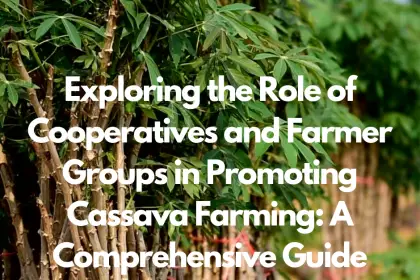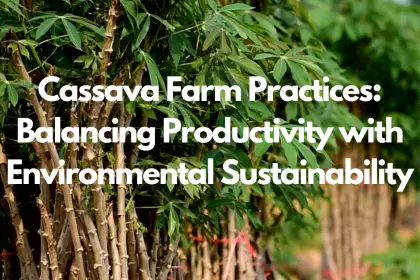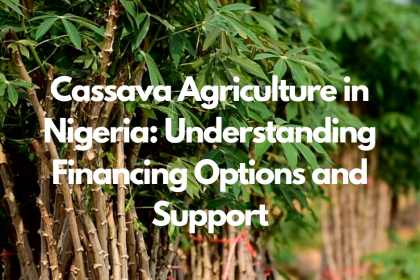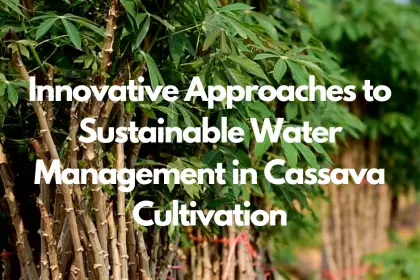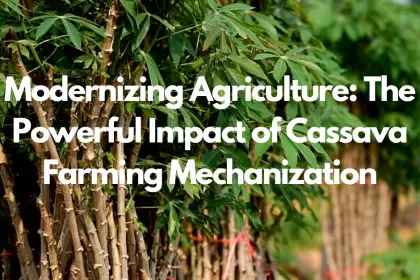Cassava, also known as Manihot esculenta Crantz, is a staple crop grown in over 100 countries, highlighting its global importance in agriculture and food security. Its resilience to harsh environmental conditions, along with its diverse applications ranging from food to biofuel production, places cassava at the heart of agronomic practices. The crop’s ability to thrive on marginal soils with minimal inputs makes it particularly vital for smallholder farmers in regions experiencing low rainfall and poor soil fertility.
This article aims to empower cassava farmers through a guide on effective agronomic practices, exploring innovative technologies and capacity-building strategies to enhance cassava crop production and storage. By addressing the challenges in training delivery and showcasing success stories, the guide seeks to elevate the cassava value chain, contributing to sustainable agricultural development and food security. Through these insights, farmers can unlock the full potential of cassava, ensuring its significant role in the global agricultural landscape.
The Significance of Cassava in Agriculture
In the realm of global agriculture, cassava emerges as a cornerstone crop, particularly within Nigeria, which stands as a leading producer. With an anticipated production output of 106 million tonnes by 2030, the significance of cassava cannot be overstated. This is further underscored by the expected yield of 7.7 tonnes/ha and the projected cropped area reaching 9.6 million hectares. Despite these promising figures, it’s crucial to note a potential decline in cassava food supply per capita, from 267 Kcal/capita/day in 2014 to 239 Kcal/capita/day by 2030, signaling a need for strategic agronomic practices and storage solutions to counteract this trend.
- Global Importance:
-
- Nigeria’s Role: World’s largest producer with a forecasted output of 106 million tonnes by 2030.
- Yield and Cropped Area: Expected yield of 7.7 tonnes/ha over 9.6 million hectares.
- Food Supply Concern: Decline in per capita food supply, highlighting the importance of enhanced production and storage techniques.
Cassava’s versatility extends beyond mere subsistence farming, serving as both a subsistence and cash crop. Its introduction into Africa by Portuguese traders several centuries ago has culminated in its status as the most important tropical root crop, providing essential dietary energy for over 500 million people globally. Its rank as the fourth most crucial food crop in developing countries, after staples like rice, maize, and wheat, showcases its pivotal role in food security.
- Versatility and Usage:
-
- Subsistence and Cash Crop: A dual role that underscores its economic value.
- Historical Significance: Centuries of cultivation since its introduction by Portuguese traders.
- Global Staple: Essential dietary energy source for over 500 million people.
Moreover, cassava’s adaptability to harsh environments, including poor soil conditions and limited water resources, underscores its resilience. This characteristic, combined with its diverse applications ranging from food products to industrial uses like ethanol production, positions cassava as a critical crop in addressing food security and economic opportunities in tropical and subtropical regions.
- Resilience and Applications:
-
- Adaptability: Thrives in challenging environments, offering a reliable food source.
- Diverse Applications: From traditional dishes to biofuel production.
- Economic Opportunities: Serves as a staple food and source of income for farmers in Africa, Asia, and Latin America.
Effective Agronomic Practices
In Brazil, India, and Thailand, smallholder cassava farmers have showcased the potential of intensive farming practices, achieving remarkable yields of 25-40 tonnes per hectare. Similarly, adopting improved varieties and enhanced agronomic practices could elevate yields in Nigeria to 25 tonnes per hectare. This highlights the pivotal role of innovative agronomic strategies in optimizing cassava production. Key practices include:
- Soil Management:
-
- Transition to zero tillage to enhance root functionality and soil health.
- Maintain organic soil cover to conserve water, nutrients, and suppress weeds, thus fostering beneficial soil biota.
- Crop Management:
-
- Intercropping with early maturing crops to protect soil and limit weed growth.
- Adopt the ‘Save and Grow’ approach, focusing on soil structure preservation, organic matter maintenance, and a diverse crop range to mitigate pests and diseases.
- Fertilization and Planting Techniques:
-
- Apply 5-10 t/ha of animal manure along with 50-100 kg/ha of N and/or K2O.
- Optimal planting methods vary with the season; vertical or inclined planting is preferable during droughts, while ridge planting is advantageous in the rainy season.
These practices are instrumental in achieving high and sustainable cassava yields, underlining the importance of agronomic practices and crop management in enhancing cassava production and storage.
Innovative Technologies for Cassava Farming
In the quest to enhance cassava farming, innovative technologies have emerged as game-changers, significantly boosting productivity and efficiency. Josephine Arisat from Busia County is a testament to this transformation, having increased her cassava yield from 0.5kg to between 2.0-5.0 kg per plant through the PlantVillage Nuru smartphone application. This AI-driven tool aids in disease diagnosis and management, proving crucial for smallholder farmers.
- Technological Advancements in Cassava Farming:
-
- PlantVillage Nuru: AI-powered app for disease diagnosis, increasing yields substantially.
- Agridrive: Offers cassava-specific machinery and advisory, enhancing field operation efficiency by over 85% and reducing drudgery.
- Genomic Resources: Development of SSR markers, a cassava haplotype map, and a chromosome-scale reference genome, facilitating breeding and crop improvement.
- Phenotyping Tools: Use of texture analyzers and high throughput imaging for evaluating cassava traits, crucial for breeding programs.
Moreover, the introduction of transformation technology has revolutionized cassava storage, extending shelf life from 2 days to 18 months, thereby reducing losses and significantly increasing farmer income. This, coupled with the use of Global Navigation Satellite Systems (GNSS) and drones for precise land preparation and crop health monitoring, underscores the pivotal role of technology in modernizing cassava farming practices. These innovations not only enhance production but also contribute to the sustainability and resilience of cassava as a staple crop.
Capacity Building Success Stories
Empowering cassava farmers through capacity-building initiatives has led to remarkable success stories across various regions. Here are some highlights:
- PIND Foundation’s Impact in Imo State, Nigeria:
-
- Before Training: Women cassava farmers struggled with low yields, barely enough to feed their families.
- After Training: Veronica Njoku and others saw their yields soar, with Veronica harvesting 50 full bags of cassava, a significant increase from her previous yield.
- Success Stories from the BEST Cassava Project:
-
- Gosberth, Tanzania: Transitioned from a novice to a successful Cassava Seed Entrepreneur (CSE), thanks to group training.
- Grace, Tanzania: As a Certified Seed Entrepreneur (CSE), she not only boosted her income but also improved her family’s living conditions.
- Helen Barasa, Kenya: Diversified her crops, leading to growth and a reduction in cassava diseases on her farm.
- Enhancing Livelihoods through Training:
-
- Osara Women Cassava Processing MPCS, Nigeria: Increased income and improved livelihood after receiving training on value addition and processing technology.
- Kouamé Akissi, Cote D’Ivoire: Boosted her revenues by 10% and founded a local cooperative, demonstrating the power of training and access to new cassava varieties.
These stories underscore the transformative power of targeted training and capacity-building efforts in improving agronomic practices, yields, and ultimately, the livelihoods of cassava farmers.
Challenges and Solutions in Training Delivery
In addressing the challenges cassava farmers face, particularly in training delivery, it’s crucial to identify specific obstacles and implement targeted solutions. Here’s a breakdown of key challenges and their mitigation strategies:
- Access to Credit and Inputs
-
- Challenge: Smallholder farmers struggle to secure credit for essential inputs.
- Mitigation: Introduction of microfinance programs, tailored to cassava farmers, coupled with financial literacy training and establishing linkages with financial institutions.
- Infrastructure and Market Access
-
- Challenge: Poor transportation and inadequate storage facilities lead to significant post-harvest losses.
- Mitigation:
-
- Invest in rural infrastructure improvement, such as roads and storage facilities.
- Develop and implement market information systems for informed selling decisions.
- Policy and Gender Inclusivity
-
- Challenges:
-
- Inadequate policies hampering cassava farming development.
- Gender-related barriers, limiting women’s access to resources and decision-making.
- Mitigation:
-
- Advocate for supportive policies through engagement with policymakers.
- Implement gender-inclusive programs, providing training, access to credit, and decision-making opportunities for women.
These strategies aim to address the multifaceted challenges in training delivery, ensuring cassava farmers are equipped with the knowledge and resources needed for sustainable and profitable farming practices.
Conclusion and Future Directions
Throughout this article, we’ve journeyed through the multifaceted world of cassava farming, examining its critical role in global agriculture and the transformative practices that can elevate its production and sustainability. From the strategic agronomic methods that promise increased yields to the innovative technologies that bring efficiency and resilience, the guide has showcased the potential for significant advancements in cassava farming. This exploration underlines the importance of empowering farmers with knowledge and resources, highlighting success stories that inspire and serve as a model for transforming the cassava value chain worldwide.
As we reflect on the insights and strategies discussed, it’s clear that the path to enhancing cassava farming involves a concerted effort across various sectors. By addressing training delivery challenges, advocating for policy support, and embracing technology, there’s a promising horizon for cassava farmers. The implications of these efforts extend beyond improved yields, touching on food security, economic opportunities, and the livelihoods of millions. Therefore, as stakeholders in the agricultural sector, our collective continued investment in research, innovation, and capacity building is essential for realizing the full potential of cassava as a cornerstone crop in the fight against hunger and poverty.
FAQs
What are the recommended agronomic practices for growing cassava?
To achieve the best yields in cassava farming, it is advised to plant cassava cuttings at intervals of 1 meter by 1 meter. An adequate nutrient supply is crucial, which can be maintained by applying fertilizers, with a preference for organic options such as farmyard manure. Four weeks after planting, it is beneficial to apply 250 grams of poultry manure per cassava plant.
What difficulties do cassava farmers encounter?
Cassava farmers often face several challenges including a lengthy period before the plants mature, variability in dry matter and starch content, high levels of cyanogenic compounds that can be toxic, poor cooking qualities, and susceptibility to diseases such as cassava bacterial blight and root rot, particularly in forested regions.
How can one achieve success in cultivating cassava?
For successful cassava cultivation, an optimal plant density is between 6,000 to 10,000 plants per hectare, which translates to a spacing of 1.5 x 1 meter or 1 x 1 meter for sole cultivation, and 2 x 2 meters when intercropping. It’s beneficial to grow cassava alongside other crops to enhance profitability and improve soil quality, with a recommended density of 2,500 plants per hectare for intercropping.
Which crop is most advantageous to grow with cassava?
When intercropping cassava, maize is a common and advantageous companion crop, particularly when cassava is the primary crop and maize is secondary. Intercropping cassava with maize or legumes has shown a biological advantage over growing these crops alone, as evidenced by (modified) Area × Time Equivalency Ratio (ATER) values exceeding one, indicating greater productivity.




